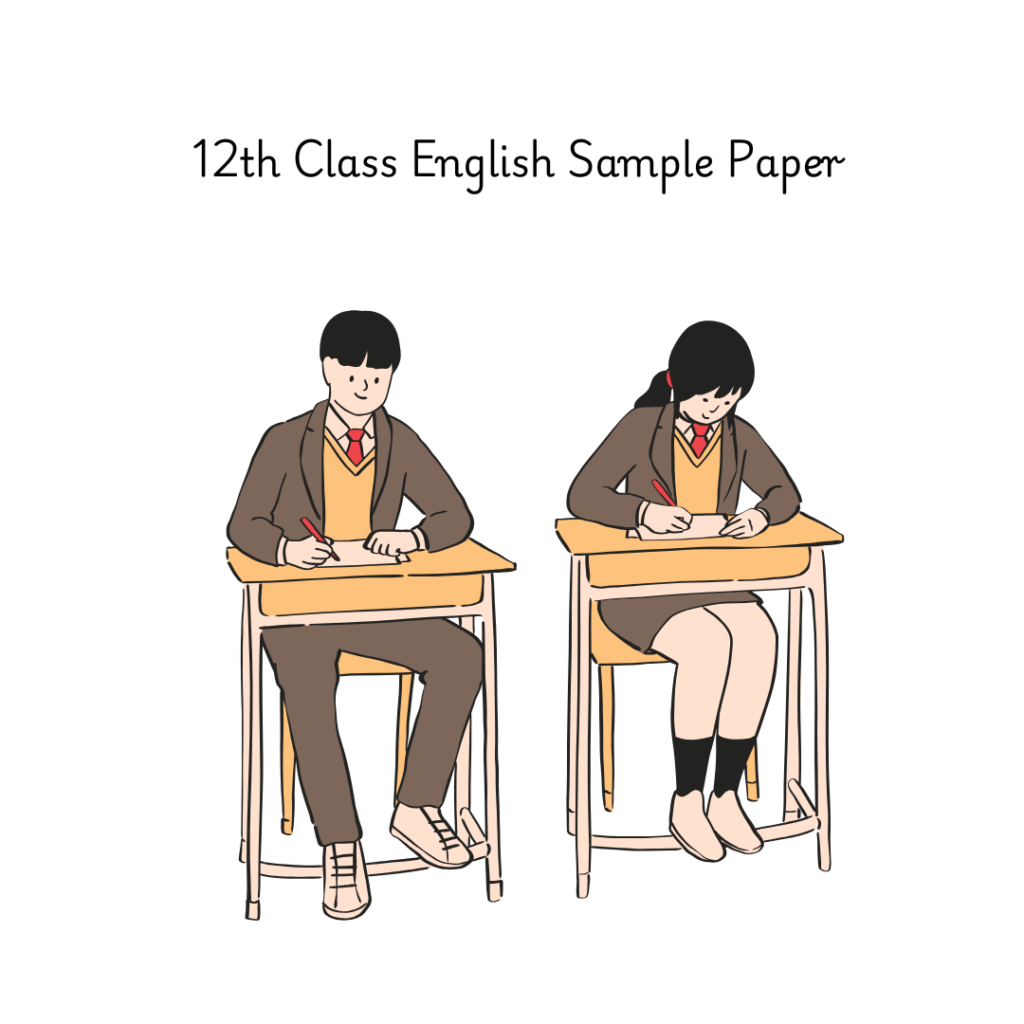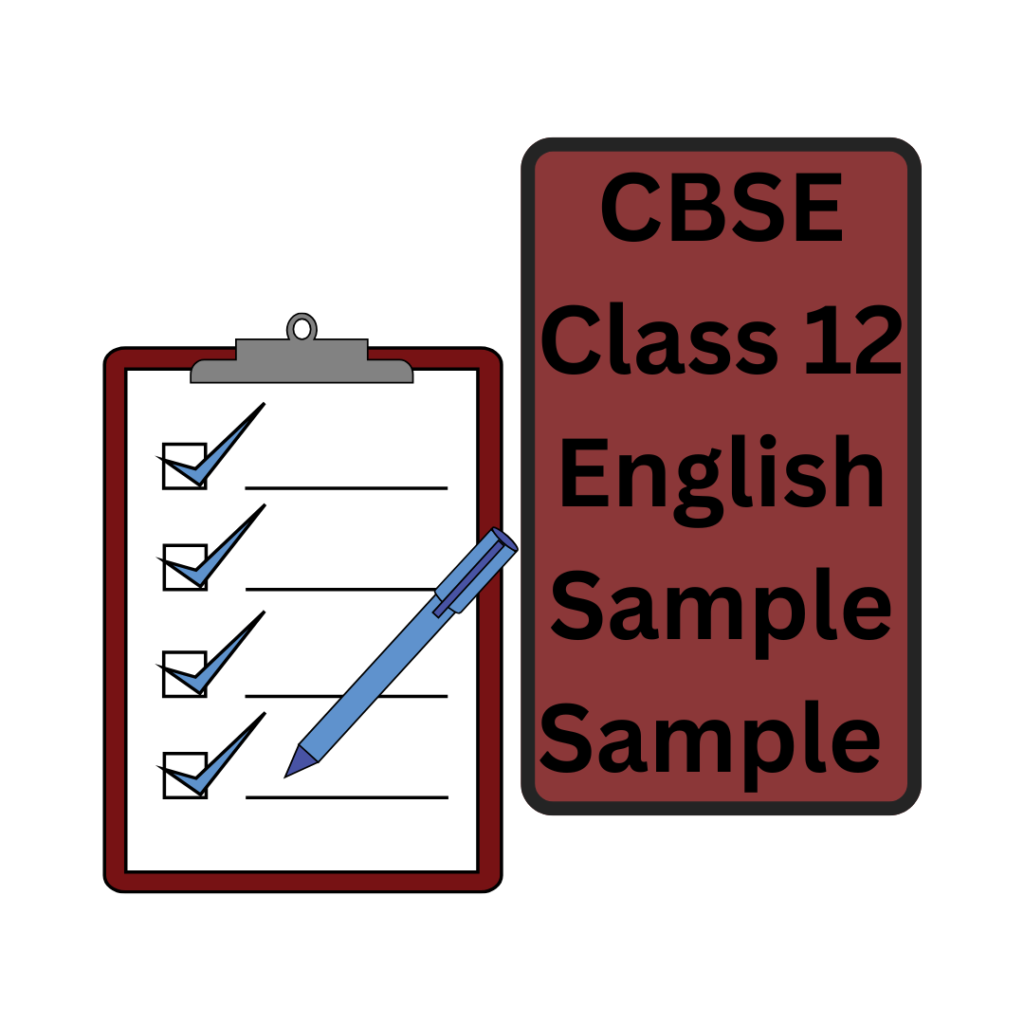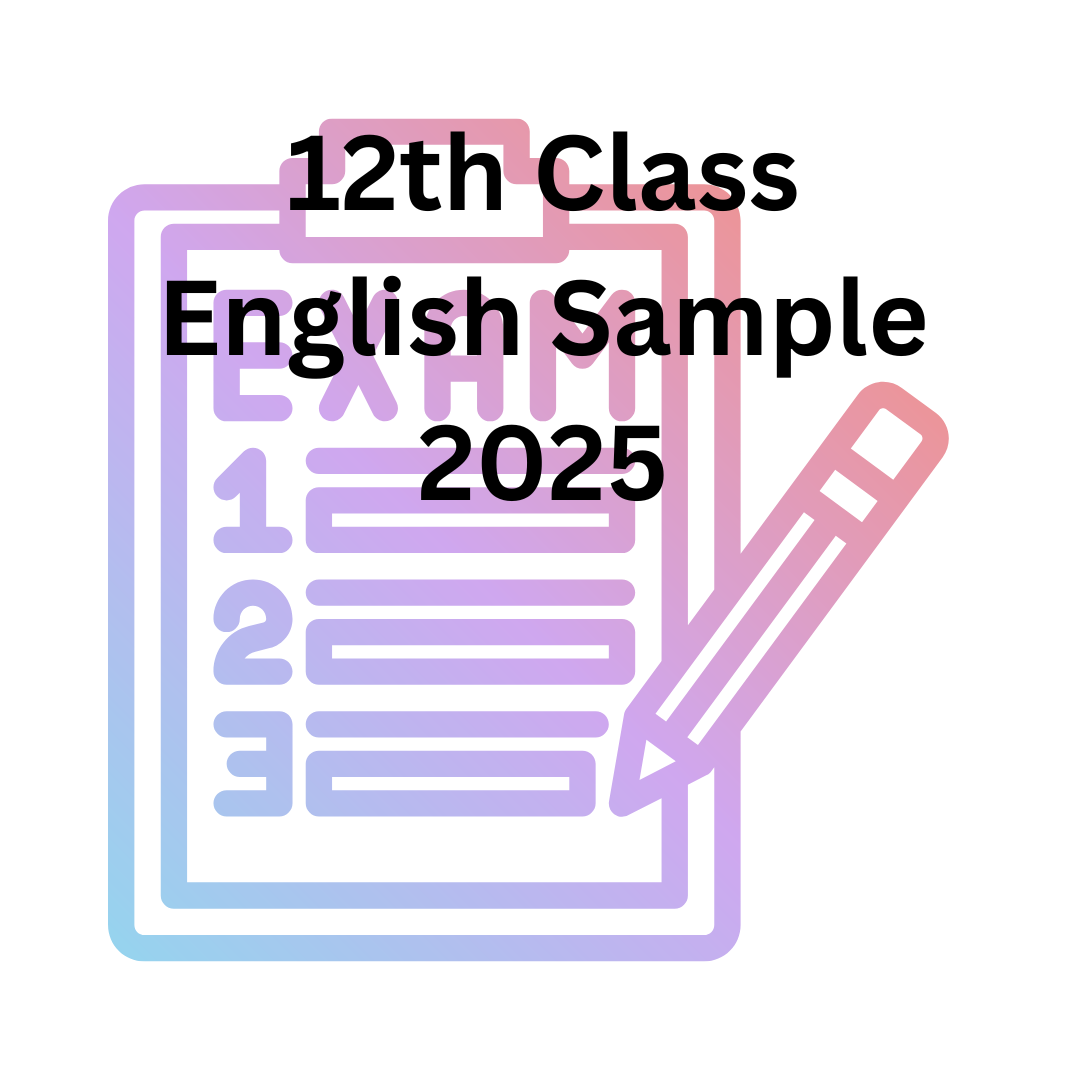12th Class English Sample 2025. “Prepare effectively for your 12th Class English exams with the 2025 sample papers. Download solved and unsolved papers, practice key questions, and excel in your board exams!” Based on Previous Year Question Paper .

12th Class English Sample 2025
CBSE Class 12 English Sample Paper
Sample Question Paper
Class XII – English Core
Time Allowed: 3 Hours
Maximum Marks: 80
General Instructions:
- This question paper contains three sections: Section A – Reading Skills, Section B – Creative Writing Skills, and Section C – Literature.
- All questions are compulsory.
- Adhere to the prescribed word limit while answering questions.
- Write the correct question number before each answer in your answer sheet.
Section A: Reading Skills (22 Marks)
1. Read the following passage carefully and answer the questions that follow: (12 Marks)
Passage:
The Role of Technology in Education
Technology has revolutionized the field of education, transforming traditional methods of teaching and learning. Over the past few decades, the integration of technology into education has not only made knowledge more accessible but has also enhanced the quality of learning experiences.
One of the significant benefits of technology in education is its ability to provide access to vast resources of information. The internet serves as a global library where students and teachers can access articles, e-books, videos, and research papers on any subject. Online platforms such as Coursera, Khan Academy, and edX offer free or affordable courses, enabling learners to acquire new skills at their convenience. Additionally, virtual classrooms and learning management systems allow for real-time interaction between students and educators, breaking geographical barriers.
Another advantage is the personalization of learning. With the help of Artificial Intelligence (AI) and data analytics, education can now cater to the individual needs of students. Adaptive learning tools assess a learner’s strengths and weaknesses, providing tailored content to improve their understanding. This approach ensures that students progress at their own pace, fostering better engagement and retention of knowledge.
However, the integration of technology in education is not without challenges. One major issue is the digital divide, which refers to the gap between those who have access to technology and those who do not. Students from underprivileged backgrounds or rural areas often lack the necessary devices or internet connectivity, leading to disparities in educational opportunities. Furthermore, over-reliance on technology can lead to reduced social interaction, as students may prefer online communication over face-to-face engagement.
Another concern is the quality of content available online. While the internet offers a plethora of information, not all of it is credible or accurate. Students may struggle to distinguish between reliable and unreliable sources, which can hinder their learning process. Moreover, the excessive use of technology can lead to health issues such as eye strain and a sedentary lifestyle.
Looking ahead, the future of technology in education appears promising. Emerging technologies such as Virtual Reality (VR) and Augmented Reality (AR) are set to revolutionize learning experiences by making them more immersive and interactive. For instance, VR can transport students to historical events or scientific laboratories, providing hands-on learning without leaving the classroom. Similarly, AR can overlay digital content onto the physical world, enhancing the understanding of complex concepts.
Artificial Intelligence is expected to play a pivotal role in automating administrative tasks for teachers, allowing them to focus more on teaching. Additionally, AI-powered chatbots can assist students with queries, providing instant support and guidance. Blockchain technology may also find applications in education, ensuring secure and transparent management of academic records.
In conclusion, technology has the potential to bridge gaps in education, making it more inclusive and efficient. While challenges such as the digital divide and content quality need to be addressed, the future scope of technology in education is undeniably vast. By leveraging the right tools and strategies, we can create a learning environment that empowers every student to reach their full potential.
Questions:
a. Choose the correct synonym for the word “pivotal” as used in the passage: (1 Mark)
(A) Minor
(B) Crucial
(C) Simple
(D) Irrelevant
b. What role does technology play in bridging educational gaps? Answer in 40 words. (2 Marks)
c. Based on the passage, why is it essential to maintain a balance between technology and traditional teaching methods? (2 Marks)
d. Fill in the blank: According to the passage, the integration of technology in education leads to ________. (1 Mark)
e. Explain how virtual reality is reshaping learning experiences. Provide evidence from the text. (2 Marks)
f. Identify the tone of the author in paragraph 3. (1 Mark)
(A) Optimistic
(B) Skeptical
(C) Critical
(D) Neutral
g. Summarize the challenges mentioned in the passage in about 40 words. (2 Marks)
2. Read the following passage carefully and answer the questions that follow: (10 Marks)
Passage:
Mental Health and Wellness in Youth
Mental health is a critical component of overall well-being, particularly for today’s youth, who face an array of challenges. From academic pressure to the influence of social media, young people are navigating a complex landscape that significantly impacts their mental health.
One of the primary sources of stress for youth is academic performance. The constant pressure to excel in studies, secure high grades, and meet parental and societal expectations often leads to anxiety and burnout. Additionally, social media, while providing a platform for connection, has also introduced challenges such as cyberbullying, comparison, and low self-esteem. These factors can contribute to feelings of loneliness, depression, and inadequacy.
Another critical issue is the lack of open communication about mental health. Many young people hesitate to share their struggles due to fear of stigma or judgment. This silence often exacerbates their problems, leading to a decline in their emotional and psychological well-being. Furthermore, inadequate access to mental health resources, particularly in rural areas, compounds the issue.
Despite these challenges, there are several ways to promote mental wellness among youth. Encouraging open conversations about mental health can help reduce stigma and make it easier for young people to seek help. Schools and communities can play a significant role by organizing workshops, counseling sessions, and mindfulness activities. Building a supportive environment at home, where children feel heard and understood, is equally vital.
In conclusion, addressing the mental health challenges faced by youth requires a collective effort from families, schools, and society at large. By prioritizing mental wellness and ensuring access to appropriate resources, we can empower young people to lead healthier and more fulfilling lives.
Questions:
a. List two main causes of stress in youth, as mentioned in the passage. (2 Marks)
b. How can mindfulness activities help youth cope with challenges? Answer in 40 words. (2 Marks)
c. State whether True or False: Financial independence is unrelated to mental well-being. (1 Mark)
d. Select the most appropriate title for the passage: (1 Mark)
(A) Youth and Productivity
(B) Stress-Free Living
(C) Mental Health Matters
(D) Challenges of Adulthood
Section B: Creative Writing Skills (18 Marks)
3. Attempt any one of the following in about 50 words: (4 Marks)
a. You are the Secretary of the Environment Club in your school. Draft a notice informing students about a tree plantation drive scheduled for next week.
OR
b. Draft a notice for the school notice board inviting students of classes XI and XII to participate in a debate competition on “The Role of AI in Human Lives.”
4. Attempt any one of the following in about 120-150 words: (5 Marks)
a. Write a letter to the editor of a national daily expressing concern over the growing problem of cyberbullying among teenagers. Provide suggestions to curb this menace.
OR
b. Write a letter to the Principal of your school requesting permission to organize a workshop on “Career Guidance and Counseling” for senior students.
5. Attempt any one of the following in about 120-150 words: (5 Marks)
a. Write an article on “The Importance of Soft Skills in the Workplace” for your school magazine. Use the given hints: [Effective communication, teamwork, adaptability, emotional intelligence].
OR
b. As a local correspondent, write a report on a cultural event recently organized in your town.
6. Attempt any one of the following in about 120-150 words: (4 Marks)
a. Design an invitation card for the annual sports meet of your school, where a renowned athlete will be the chief guest.
OR
b. Write a formal reply declining an invitation to a seminar on “Environmental Conservation,” citing prior commitments.
Section C: Literature (40 Marks)
7. Read the following extracts and answer the questions for any one of the two: (6 Marks)
Extract 1: [Extract from “A Thing of Beauty”]
Questions:
a. What does the poet mean by “A bower quiet for us”? (2 Marks)
b. Identify the poetic device in “Full of sweet dreams, and health, and quiet breathing.” (1 Mark)
c. How does the poet portray the everlasting nature of beauty? (3 Marks)
OR
Extract 2: [Extract from “The Tiger King”]
Questions:
a. Why did the Tiger King decide to marry? (2 Marks)
b. What does the phrase “throne of guilt” signify in the context of the extract? (1 Mark)
c. How does this extract highlight the theme of power and its misuse? (3 Marks)
8. Answer any five of the following in about 40-50 words each: (5×2=10 Marks)
a. Explain why Derry felt inferior in “On the Face of It.”
b. Describe the significance of the Champaran episode in “Indigo.”
c. What is the irony in the peddler’s defense in “The Rattrap”?
d. How does the author portray childhood memories in “My Mother at Sixty-Six”?
e. Why is the experience of Antarctica considered enlightening in “Journey to the End of the Earth”?
9. Answer any one of the following in about 120-150 words: (5 Marks)
a. How does the poem “Keeping Quiet” emphasize the importance of introspection and silence?
OR
b. Analyze the central conflict in “The Enemy” by Pearl S. Buck.
10. Answer any one of the following in about 120-150 words: (5 Marks)
a. Discuss the theme of courage and resilience in “The Last Lesson” by Alphonse Daudet.
OR
b. Compare the characters of Mr. Lamb and Derry in “On the Face of It.”
End of Question Paper

That’s all for 12th English Sample Paper , Class 12 English Model Question, CBSE class 12 English Sample Paper, Cbse Class 12 English previous year question paper
Download CBSE Class 12 English Previous Year Paper
I hope 12th English Sample Paper, Class 12 English Model question, CBSE class 12 English Sample Paper, cbse Class 12 english previous year question papers, was helpful for you.
You can follow us on Instagram: https://www.instagram.com/stationvidya/
Facebook: https://www.facebook.com/stationvidya/
You tube: https://www.youtube.com/@stationvidya/
We hope you’d loved the content , please do like, share and comment.
Subscribe for notification

Leave a Reply